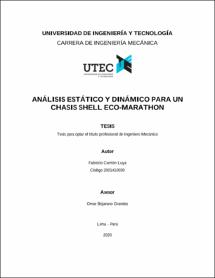| dc.contributor.advisor | Bejarano Grández, Omar | |
| dc.contributor.author | Carrión Luya, Fabrizio | |
| dc.date.accessioned | 2021-01-28T22:01:01Z | |
| dc.date.available | 2021-01-28T22:01:01Z | |
| dc.date.issued | 2020 | |
| dc.identifier.citation | Carrión Luya, F. (2020). Análisis estático y dinámico para un chasis shell eco-marathon [Tesis de Título Profesional, Universidad de Ingeniería y Tecnología]. Repositorio Institucional UTEC. https://hdl.handle.net/20.500.12815/176 | es_PE |
| dc.identifier.uri | https://hdl.handle.net/20.500.12815/176 | |
| dc.description.abstract | En la presente investigación se analizó estática y dinámicamente el primer chasis Shell Eco-marathon desarrollada en la Universidad de Ingeniería y Tecnología. La metodología de investigación utilizada fue la propuesta por S. Hernández, donde se presentan las siguientes fases: elaboración de hipótesis y definición de variables, desarrollo del diseño de investigación, definición y selección de la muestra, recolección y análisis de datos. Como resultado final se esperó obtener un chasis apropiadamente analizado bajo cuatro pruebas estáticas y dinámicas. El chasis del cual se partió tiene una geometría definida, donde se fue cambiando las dimensiones de las secciones transversales de los perfiles tubulares para determinar el comportamiento estático y dinámico de cada una de las iteraciones. En los análisis estáticos, se analizó 39 secciones transversales de perfiles de aluminio 6061-T6 frente a fuerzas de frenado, toma de curvas y prueba de resistencia de la jaula anti-volcadura. En este análisis se buscó que ningún componente tubular supere el esfuerzo permisible de 95 Mpa. Con respecto a los análisis dinámicos, se analizó los perfiles que cumplieron satisfactoriamente el criterio de selección anteriormente mencionado. A dichos perfiles se les analizó bajo pruebas de impacto frontal y análisis modal. El impacto frontal tuvo dos criterios de selección, primero que los pies del piloto no sean aplastados por la deformación causada por el impacto y segundo que la cabeza del piloto no experimente una desaceleración superior a los 80g. El análisis modal buscó comprobar que los modos de vibración de la estructura no resuenen con las del motor. Después de cumplir los criterios anteriores, la sección transversal con un menor peso fue el seleccionado. El perfil seleccionado aseguro ser seguro para el piloto y a la vez ligero. Se cumplió con todos los requerimientos dados por las reglas de la competición, así como las condiciones de manejo durante la carrera. | es_PE |
| dc.description.abstract | In the present investigation, the first Shell Eco-marathon chassis developed at the University of Engineering and Technology was statically and dynamically analyzed. The research methodology used was that proposed by S. Hernández, where the following phases were presented: Elaboration of hypotheses and definition of variables, development of the investigation design, definition and selection of the sample, data collection and analysis. As final result, it was expected to obtain a properly analyzed chassis under four static and dynamic tests. The chassis from which it was started has a defined geometry, where the dimensions of the cross sections of the tubular profiles were changed to determine the static and dynamic behavior of each of the iterations. In the static analyzes, 39 cross sections of 6061-T6 aluminum profiles were analyzed against braking forces, cornering and roll cage strength testing. In this analysis, it was sought that no tubular component exceeds the allowable stress of 95 MPa. Regarding the dynamic analyzes, the profiles that satisfactorily meet the selection criteria mentioned above will be analyzed. These profiles were analyzed under frontal impact tests and modal analysis. The frontal impact had two selection criteria, first that the pilot's feet are not trapped by the deformation caused by the impact and second that the pilot's head does not experience a deceleration greater than 80g. The modal analysis sought to verify that the vibration modes of the structure do not resonate with those of the motor. Having met the above criteria, the cross section with the lowest weight was selected. The selected profile assured to be safe for the pilot and at the same time light weight. Complying with all the requirements given by the competition rules, as well as the driving conditions during the race. | es_PE |
| dc.description.uri | Tesis | es_PE |
| dc.format | application/pdf | es_PE |
| dc.language.iso | spa | es_PE |
| dc.publisher | Universidad de Ingeniería y Tecnología | es_PE |
| dc.rights | info:eu-repo/semantics/openAccess | es_PE |
| dc.rights.uri | http://creativecommons.org/licenses/by-nc-nd/4.0/ | |
| dc.source | Repositorio Institucional UTEC | es_PE |
| dc.source | Universidad de Ingeniería y Tecnología - UTEC | es_PE |
| dc.subject | Análisis estático | es_PE |
| dc.subject | Análisis dinámico | es_PE |
| dc.subject | Automóviles--Chasís | es_PE |
| dc.subject | Shell Eco-marathon | es_PE |
| dc.subject | Carrocerías | es_PE |
| dc.title | Análisis estático y dinámico para un chasis shell eco-marathon | es_PE |
| dc.title.alternative | Static and dynamic analysis of a shell ecomarathon chassis | es_PE |
| dc.type | info:eu-repo/semantics/bachelorThesis | es_PE |
| dc.subject.ocde | https://purl.org/pe-repo/ocde/ford#2.03.01 | es_PE |
| dc.publisher.country | PE | es_PE |
| thesis.degree.discipline | Ingeniería Mecánica | es_PE |
| thesis.degree.grantor | Universidad de Ingeniería y Tecnología. Ingeniería Mecánica | es_PE |
| thesis.degree.level | Título Profesional | es_PE |
| thesis.degree.name | Ingeniero Mecánico | es_PE |
| renati.advisor.dni | 43219393 | |
| renati.author.dni | 70365774 | |
| renati.discipline | 713046 | es_PE |
| renati.juror | Noel, Julien Georges Andre | |
| renati.juror | Antezano Inga, Tulio Antonio | |
| renati.juror | Ramos Saravia, José César | |
| renati.level | https://purl.org/pe-repo/renati/level#tituloProfesional | es_PE |
| renati.type | https://purl.org/pe-repo/renati/type#tesis | es_PE |


